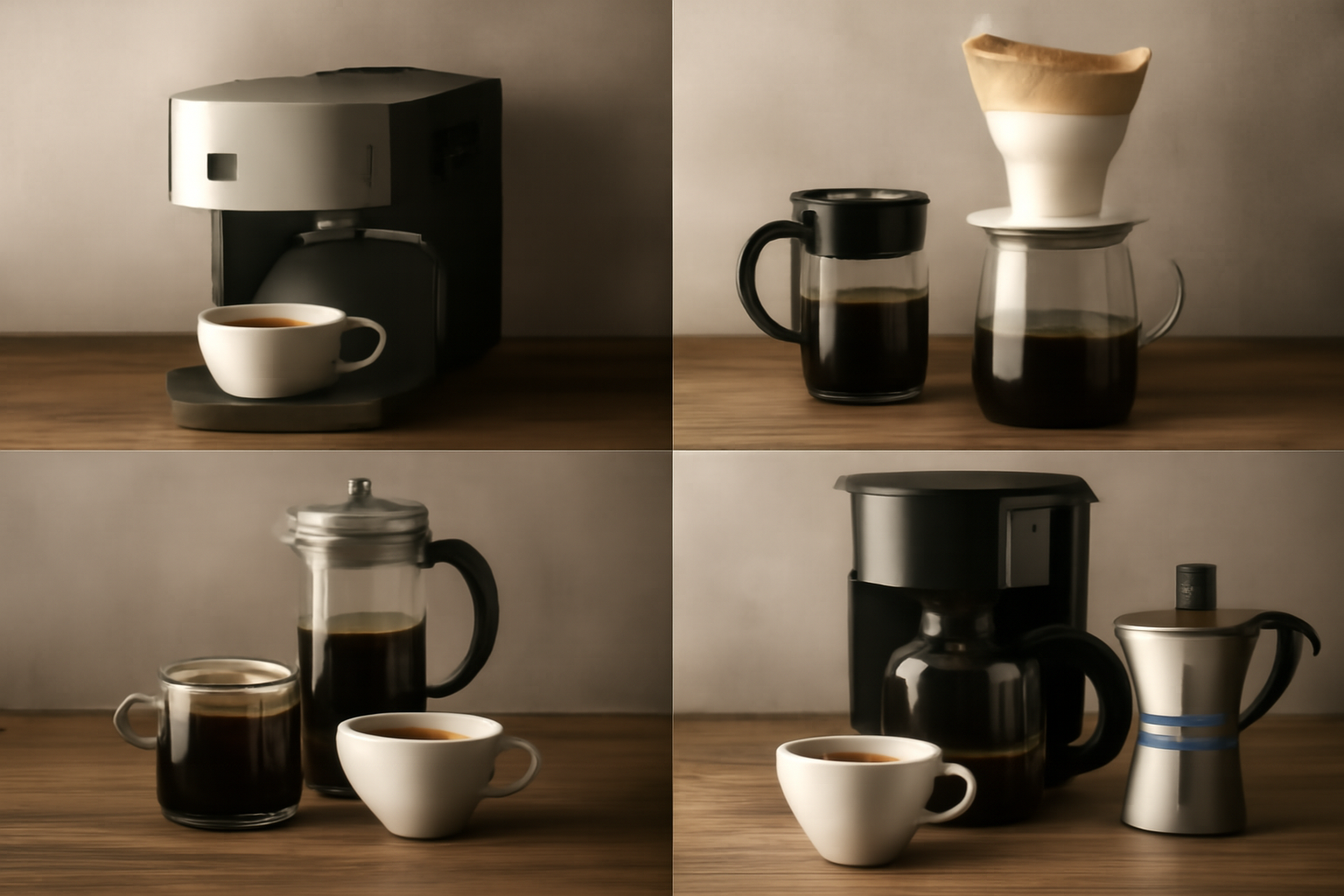Coffee is more than just a morning pick-me-up; it’s a global culture, an art form, and for many, a lifestyle. There are countless ways to brew coffee, each with its unique characteristics and nuances. The method you choose can drastically alter the flavor, body, and texture of your cup. Whether you’re a seasoned coffee lover or just starting your journey, understanding different brewing methods is key to making the perfect cup of coffee.
In this guide, we’ll explore the most popular coffee brewing methods, their benefits, and how each one affects the flavor of your coffee. From traditional methods like French Press and pour-over to more modern approaches like Aeropress and siphon brewing, we’ll cover everything you need to know to become a coffee expert.
1. Espresso: The Foundation of Coffee
Espresso is the heart and soul of many popular coffee drinks, such as lattes, cappuccinos, and Americanos. It’s a concentrated coffee made by forcing hot water through finely-ground coffee beans under high pressure. The result is a small but rich shot of coffee with a thick, golden crema on top.
How It Works:
- Grind Size: Fine grind, almost like powdered sugar.
- Brewing Time: 25-30 seconds.
- Ratio: 1:2 (coffee to water), resulting in a concentrated shot.
Flavor Profile:
Espresso has a full-bodied flavor with rich and intense notes of chocolate, caramel, and sometimes a hint of fruitiness. The high pressure helps extract the oils from the coffee, giving it a thicker texture and deeper flavor.
Equipment Needed:
- Espresso machine (semi-automatic or automatic)
- Burr grinder for precise grinding
- Tamper for pressing the coffee grounds
2. French Press: Rich and Full-Bodied Coffee
The French press, also known as a press pot or plunger pot, is a popular method for making coffee due to its simplicity and the rich, full-bodied flavor it produces. This method involves steeping coarsely ground coffee in hot water for several minutes before pressing the coffee grounds with a plunger to separate them from the brewed coffee.
How It Works:
- Grind Size: Coarse grind, similar to breadcrumbs.
- Brewing Time: 4-5 minutes.
- Ratio: 1:15 (coffee to water).
Flavor Profile:
French press coffee is known for its rich and bold flavor, with a full body and thicker texture. It often features a stronger, more robust coffee flavor compared to methods like pour-over or drip brewing. Because the coffee grounds remain in contact with water for an extended period, more oils and fine particles make it into the cup, resulting in a fuller flavor.
Equipment Needed:
- French press (also called press pot or plunger pot)
- Coarse ground coffee
- Hot water
3. Pour-Over: Clean and Crisp Coffee
Pour-over brewing is one of the most popular manual brewing methods, especially among coffee enthusiasts. It involves pouring hot water over coffee grounds in a filter, allowing the water to slowly drip through and extract the coffee’s flavors. The beauty of pour-over is that it allows for precise control over the brewing process, including water temperature and pouring technique.
How It Works:
- Grind Size: Medium grind, similar to sea salt.
- Brewing Time: 2.5-3.5 minutes.
- Ratio: 1:16 (coffee to water).
Flavor Profile:
Pour-over coffee is known for its clean, crisp taste. The paper filter removes many of the coffee’s oils and fine particles, which results in a cup that’s light, clear, and vibrant. This method is great for showcasing the complex, nuanced flavors of high-quality beans, especially single-origin coffees with fruity or floral notes.
Equipment Needed:
- Pour-over dripper (e.g., Hario V60, Chemex, or Kalita Wave)
- Paper filters
- Kettle (preferably with a gooseneck spout for precise pouring)
- Coffee scale (optional for precision)
4. Aeropress: Fast and Versatile Brewing
The Aeropress is a relatively new addition to the world of coffee brewing, but it has quickly gained popularity for its versatility and quick brewing time. This method involves steeping coffee grounds in hot water and then forcing the coffee through a filter using air pressure.
How It Works:
- Grind Size: Medium-fine grind, similar to table salt.
- Brewing Time: 1-2 minutes.
- Ratio: 1:15 (coffee to water).
Flavor Profile:
Aeropress coffee is smooth and balanced, with a rich body and less acidity than pour-over. The coffee tends to be less bitter, with a clean taste, but the brew is still strong and full-bodied due to the pressure used during extraction.
Equipment Needed:
- Aeropress device
- Coffee filter (paper or metal)
- Aeropress filter holder or metal filter (optional)
- Stirrer or spoon for agitation
5. Cold Brew: Smooth and Refreshing Coffee
Cold brew coffee is made by steeping coarsely ground coffee in cold water for an extended period (usually 12-24 hours). Unlike iced coffee, which is brewed hot and cooled down, cold brew is brewed at a low temperature, resulting in a smoother, sweeter cup.
How It Works:
- Grind Size: Coarse grind, similar to raw sugar.
- Brewing Time: 12-24 hours.
- Ratio: 1:4 (coffee to water).
Flavor Profile:
Cold brew coffee is known for its smooth, mellow flavor with low acidity. The long extraction time allows the coffee to extract slowly, bringing out natural sweetness and chocolatey, nutty flavors. It’s a great option for those who prefer a less acidic, more refreshing coffee.
Equipment Needed:
- Cold brew maker or a large jar
- Coarse ground coffee
- Filter or cheesecloth for straining
6. Siphon Brewing: Theatrical and Flavorful Coffee
Siphon brewing is a unique and visually impressive method that uses vacuum pressure to brew coffee. This method involves two chambers: one for water and the other for coffee grounds. As the water heats up, it moves into the coffee chamber, and then, as it cools, the coffee is drawn back into the lower chamber, creating a vacuum.
How It Works:
- Grind Size: Medium grind, similar to table salt.
- Brewing Time: 5-7 minutes.
- Ratio: 1:15 (coffee to water).
Flavor Profile:
Siphon brewing produces a clean, bright cup with a medium body. The brewing process extracts a wide range of flavors from the coffee, resulting in a nuanced and complex cup. Because of the vacuum pressure, the coffee tends to have a slightly lighter body than French press or Aeropress, but with a rich, full flavor.
Equipment Needed:
- Siphon coffee maker
- Filter (usually fabric or paper)
- Heat source (usually a butane torch or alcohol burner)
7. Drip Coffee: Convenient and Consistent Brewing
Drip coffee is one of the most popular methods of brewing, especially in the U.S. It involves using an electric coffee maker to brew coffee by dripping hot water through a filter containing ground coffee. This method is simple, convenient, and consistent.
How It Works:
- Grind Size: Medium grind, similar to sand.
- Brewing Time: 4-6 minutes.
- Ratio: 1:15 (coffee to water).
Flavor Profile:
Drip coffee produces a clean, smooth cup with a mild body. It’s typically not as bold or rich as espresso or French press coffee, but it offers a light and easy-to-drink flavor that’s perfect for everyday drinking.
Equipment Needed:
- Drip coffee maker
- Coffee filters
- Pre-ground coffee or freshly ground coffee
8. Moka Pot: Strong and Bold Coffee
The Moka pot, also known as a stovetop espresso maker, is a small, classic coffee brewer that brews coffee by passing boiling water pressurized by steam through ground coffee. While it’s not technically an espresso machine, the Moka pot produces a rich, concentrated coffee similar to espresso.
How It Works:
- Grind Size: Fine grind, similar to table salt.
- Brewing Time: 5-7 minutes.
- Ratio: 1:2 (coffee to water).
Flavor Profile:
Moka pot coffee is bold, rich, and robust, with a slight bitterness and a thick texture. It’s a great option for those who want a strong cup without the complexity of an espresso machine.
Equipment Needed:
- Moka pot
- Ground coffee (fine grind)
9. Conclusion: Finding Your Perfect Brewing Method
There is no “one size fits all” when it comes to brewing coffee, as each method brings out different flavors and textures. Whether you prefer the complexity of pour-over, the smoothness of cold brew, or the boldness of espresso, experimenting with different brewing methods will help you discover the coffee that best suits your taste preferences.
The key to brewing great coffee is understanding how each method works and how it influences the final cup. With the right equipment and a bit of practice, you’ll be able to craft the perfect brew every time.

I’m an economist with 15 years of experience in strategic planning and a lifelong passion for wellness and natural living. As a self-learner, I created Herbalife Balance to share insights on healthy eating, mindful habits, and an active lifestyle. Tennis enthusiast and nature lover, I believe in balance as a path to well-being. Through this blog, I help others live healthier, more conscious lives.

